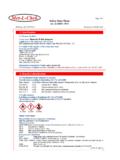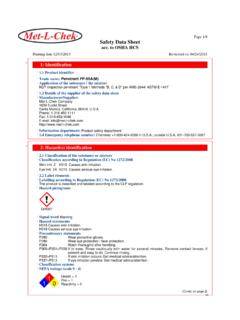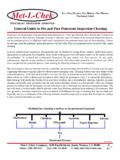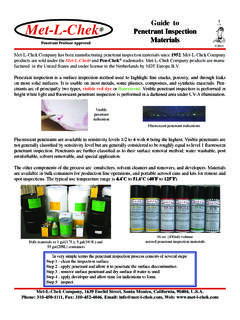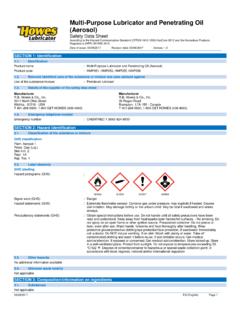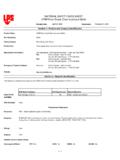Transcription of Met-L-Chek Safety Data Sheet Date Revised …
1 Safety data SheetD-70( aerosol )Page 1 of 3 date Revised 12/17/2014 Supersedes 11/10/2014 Met-L-Chek 3 Composition/information on ingredients::Ingredient(s): CAS # % by Weight EC # 2-propanol (Isopropanol) 67-63-0 40-50 200-661-7 Propellant (petroleum gas liquified) 68476-85-7 40-50 270-704-2 Hydrous megnesium silicate (talc)
2 * 14807-96-6 1-5 238-877-9*contains < quartz 14808-60-7 < Product and Company identification: Product Name: D-70 Developer ( aerosol )Manufacturer: Met-L-Chek Company 1639 Euclid Street Santa Monica, California, 90404, Phone: +1-310-450-1111 Fax : +1-310-452-4046E-mail: Phone #: Chemtrec +1-800-424-9300 in ; outside 001-703-527-3887 Recommended Use: NDT Inspection developer per ASTM E-165 & ASTM E-1417, form d & on Use: Flammable, avoid use near open flames or ignition source, avoid concentrated by: Met-L-Chek Company 12/17/20142 Hazards identification:GHS: Classification: Extremely flammable aerosol (category 1) Acute toxicity, inhilation (category 4).
3 Skin irritation (category 3) Eye irritation (category 2A) Specific target organ toxicity - single exposure (category 3), Central nervous :Signal Word: DangerHazard Statements: H222: Extremely flammable aerosol H229: Pressurized container: may burst if heated. H316: Causes mild skin irritation. H319: Causes serious eye irritation. H335: May cause repiratory irritation.
4 H336: May cause drowsiness or statements: P102: Keep out of reach of children. P210: Keep away from heat, hot surfaces, sparks, open flames and other ignition sources. No smoking. P211: Do not spray on an open flame or ignition source. P251: Do not pierce or burn, even after use. P261: Avoid breathing fumes/gas/mist/vapors/spray.
5 P280: Wear protective glove/clothing/eye protection/face protection. P284: In case of inadequate ventilation wear respiratory protection P410: Protect from sunlight P412: Do not expose to temperatures exceeding 50 C/122 Hazards: Extremely Flammable aerosol ,Target Organ Effect, IrritantHMIS Classification: Health hazard-2, Flammability-4, (Canada): A, B5,D2 BEC: Xi-Irritant; F-Flammable; R-12(Extremely Flammable;, R-36,(Irritating to eyes).)
6 R-67(Vapors may cause drowsiness or dizzi-ness). Met-L-Chek Company, 1639 Euclid Street, Santa Monica, California, 90404, : 310-450-1111 Fax: 310-452-4046 E-mail: Web: 2 of 3 date Revised 12/17/2014 Supersedes 11/10/14 Safety data SheetD-70( aerosol )7 Handling and storage:Handling: Avoid contact with skin and eyes. Avoid inhalation of vapors or mist. Use explosion-proof equipment. Keep away from sources of ignition. Protect from build up of static charge, ground containers when transferring product. Containers may be hazardous when empty since residue liquid and vapors may be present.
7 Storage: Store in a cool, dry well-ventilated location, away from areas where fire hazard or ignition sources may exist. Store and use in NO SMOKING Do not expose to temperatures over 50 C/122 F. Keep out of direct First-aid measures:GHS response statements:IF SWALLOWED: Rinse mouth, Do Not induce vomiting, get medical attention if feeling ON SKIN: Wash with plenty of water. If skin irritation occurs, get medical INHALED: Remove person to fresh air and keep comfortable for breathing, get medical advice/attention if you feel IN EYES: Rinse cautiously with water for several minutes.
8 Remove contact lenses, if present and easily to do. Continue rinsing, get medical ON CLOTHING: Take off contaminated clothing and wash it before Fire-fighting measures:Suitable extinguishing agents: Alcohol resistant foam, dry powder, carbon dioxide (CO2), water haze. For Safety reasons water spray is an unsuitable extinguishing agent, but may be used to cool unopened combustion products: Carbon monoxide and carbon protective equipment for fire-fighters: Wear self-contained respiratory protective device. Wear fully protective Point: -60 C(-76 F) propellant Explosive Limit: propellant Autoignition Temperature: 365 C (689 F)propellant6 Accidental release measures:Spill: Evacuate area.
9 Ventilate area. Remove all sources of ignition. Wear protective gear. Vapors can accumulate in low areas to form explosive concentrations. Collect liquid in an appropriate container or absorb with an inert material such as vermiculite, dry sand, or earth; DO NOT use combustible materials. Place in a chemical waste container. DO NOT flush to Exposure controls/personal protection:Eye Protection: Chemical splash goggles, face Protection: Wear resistant gloves such as Nitrile Rubber, impervious clothing, apron and boots are suggested as System: A system of local or general exhaust is recommended to keep employee exposure below the airborne exposure limits.
10 If exposure limit is exceeded use organic vapor respirator (type A), or self contained breathing Limits: 2-Propanol; CAS 67-63-0 TWA 200 ppm ACGIH (TLV) STEL: 400 ppm ACGIH (TLV) TWA : 400 ppm /980 mg/m3 (OSHA Table Z-1 limits for air contaminants) STEL : 500 ppm /1225 mg/m3 (OSHA Table Z-1 limits for air contaminants)For dry powder nuisance exposue use type P96(US) or type Pi(EU EN143 particle respirator. For higher level protection use type OV/AG/P99(US or ABEK-P2(EU EN 143) respirator Limits: Hydrous magnesium silicate; CAS14807-96-6(< 1% quartz) dry powder.))

